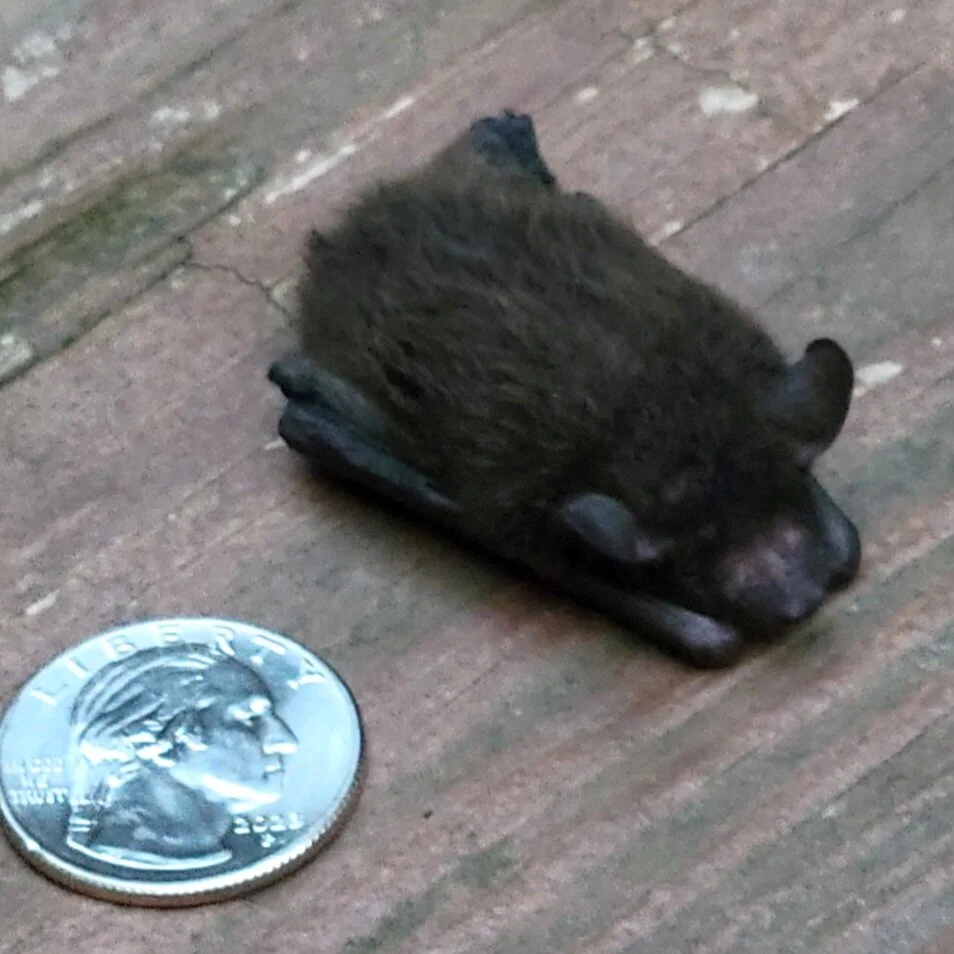For 5 years now my wife and I have enjoyed the presence of bats in a “Rocket house” built by a customer–friend that traded it to me for some bags of birdseed. I have to say I got the better end of that deal. Those bags of birdseed are long gone, however, the bat box is a source of fun and interest between March and October as our bat population has grown to over 250 now.
Only this spring we learned they are known as Evening bats, Nycticeius Humeralis. We were able to connect with a person from the Tennessee Nature Conservancy who came to our home to observe the bats exiting the box. He filmed them and used a sound device that records and translates their “calls” to sonograms. Each bat species’ call has a unique and identifiable sonogram. During his visit we counted approximately 150 bats leaving the box.
Then came the night of June 9th and we were watching the bats emerge when we saw something fall from the box and not fly. Upon a closer look I was shocked to discover a baby bat, perhaps just a day or two old clinging to the post the box is mounted on. We suspected but now had proof our colony of bats are females raising babies.
Baby Evening Bat.
The Evening bat is an abundant bat throughout the southeastern US, north to the upper Midwest and Ontario, and along the Atlantic seaboard into Florida.
The evening bat is almost never encountered in caves and is considered a forest bat. It forms nursery colonies in hollow trees, sometimes in buildings and attics, and fortunately for us, in bat houses. Some maternity colonies are quite large, containing several hundred individuals. Evening bats emerge soon after dusk and forage on a large array of small nocturnal insects including flying ants, Japanese beetles, June beetles, and moths. Take note mosquitos were not mentioned. While they may eat mosquitos when encountered, bats are typically feeding at a more elevated level while mosquitos are closer to ground level.
In the fall, evening bats store large amounts of fat for a potentially lengthy migration to southern parts of their range. In a banded bat recovery study, evening bats were found as far as 300 miles south of their banding sites. Still, little research has been done to learn the exact migration movements of this species. The bats have not been found hibernating in local caves and simply disappear from their summer habitat. Once these bats have arrived at their wintering sites, they are thought to remain active throughout the winter.
Breeding occurs in the fall, and delayed fertilization allows for the birth of 1-2 young in late May through June. Young begin to fly after 3 weeks but continue to nurse until 6 to 9 weeks.
On another recent evening as we watched the bats emerge one flew directly toward us somewhat awkwardly and as if it realized it had made a mistake crash landed onto the deck between us.
The picture is the young bat aside a quarter I placed next to it for perspective. I assisted the little bat in getting back to the post where it climbed up into the box safely. From our counts earlier in the spring of around 150 to our counts now of over 250 it’s reasonable to conclude we are seeing over 100 offspring. Clearly there is some overcrowding and we are going to add another Rocket house nearby to, hopefully, encourage more. Other bat houses are good, too, and I recommend visiting the websites below to learn more. It’s interesting that the more we learn about these docile, beneficial, creatures the more questions we have. We hope to continue cultivating the success we are experiencing and learn much more in years to come.
Other species of bats seen in TN include Brazilian free-tailed, Eastern pipistrelle, Eastern Red bat, Eastern Small footed, Gray, and Hoary bat.


